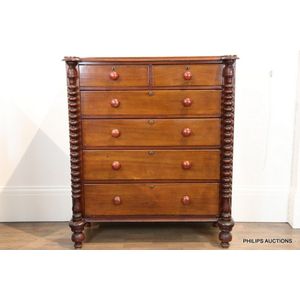Victorian Cedar Chest with Bobbin Carved Pillars
You must be a subscriber, and be logged in to view price and dealer details.
Subscribe Now to view actual auction price for this item
When you subscribe, you have the option of setting the currency in which to display prices to $Au, $US, $NZ or Stg.
- Bobbin Turning - This turning resembles a series of compressed spheres, not unlike a row of beads or bobbins. Commonly associated with Jacobean-style furniture, bobbin turning is also found on a wide variety of small cedar and pine tables and washstands made in Australia during the late 19th century and up to the first world war.
- Turning - Any part of a piece of furniture that has been turned and shaped with chisels on a lathe. Turned sections include legs, columns, feet, finials, pedestals, stretchers, spindles etc. There have been many varieties and fashions over the centuries: baluster, melon, barley-sugar, bobbin, cotton-reel, rope-twist, and so on. Split turning implies a turned section that has been cut in half lengthwise and applied to a cabinet front as a false decorative support.
- Bun Feet - Similar to ball feet, though somewhat compressed or flattened in appearance. Introduced during the late 17th century, but they have been used on furniture up to the present day.
- Victorian Period - The Victorian period of furniture and decorative arts design covers the reign of Queen Victoria from 1837 to 1901. There was not one dominant style of furniture in the Victorian period. Designers used and modified many historical styles such as Gothic, Tudor, Elizabethan, English Rococo, Neoclassical and others, although use of some styles, such as English Rococo and Gothic tended to dominate the furniture manufacture of the period.
The Victorian period was preceded by the Regency and William IV periods, and followed by the Edwardian period, named for Edward VII (1841 ? 1910) who was King of the United Kingdom and the British Dominions and Emperor of India for the brief period from 1901 until his death in 1910.
This item has been included into following indexes:
Visually similar items

A Louis XV style tulipwood semainier, circa 1930, with a mottled yellow marble shaped top above seven drawers each with quarter veneer shaped panels and stringing, the sides conforming, with a shaped apron and raised on short cabriolet legs, with gilt bron

Antique Georgian 1790's chest on chest, Ex Northern England region, displaying fine inlaid Tunbridge banding, canted sides, oval repousse brass back plate handles, cock beaded edge to the drawers, shaped bracket feet. Fine example and clean, approx 185 cm

A Georgian oak provincial chest on chest, early 19th century, in honey toned oak having an extended shaped cornice above two half and six full width drawers of graduating depth all with mahogany cross banded edges and stringing, swing brass handles and con

A French walnut and inlaid tall chest, the marble top above seven drawers with ring ormolu handles flanked by pilasters with ormolu corbels on turned feet. 145 cm high, 70 cm wide, 38 cm deep
